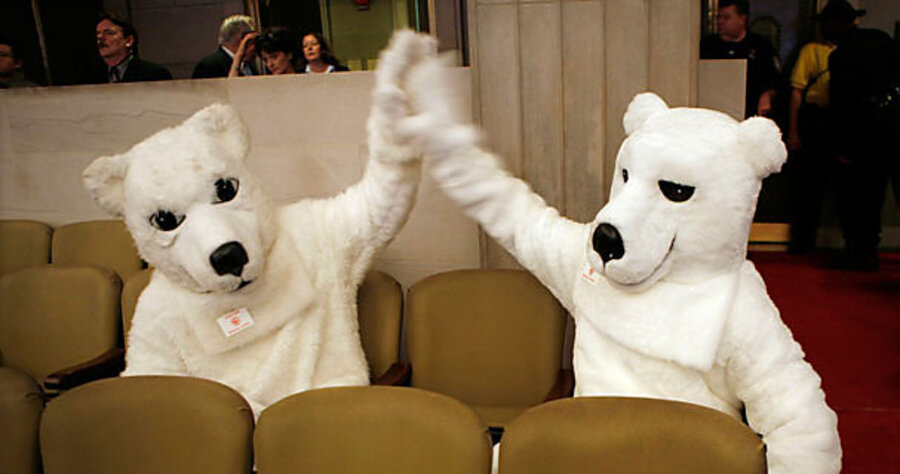US lists polar bears as threatened
Loading...
It’s official: The polar bear is threatened and is likely to become endangered if actions aren’t taken to stem the loss of its habitat. That was the decision of the Interior Department, which on Wednesday issued a long-awaited decision to list the polar bear under the Endangered Species Act.
It is the first time a species has been listed due to a threat from global warming, and raises it questions about the scope and ability of the act to address such a complex global concern.
Interior Secretary Dirk Kempthorne sought to answer some of those questions in announcing the listing, which comes one day before the deadline imposed for the decision by a federal district court.
“The Endangered Species Act is not the means, nor the method, nor the vehicle by which you can deal with global climate change,” he said in a press briefing, noting that the listing will not hold individual sources of carbon emissions responsible for contributing to the decline of the polar bear.
In addition, the department is seeking to clarify the scope of the act by invoking a special “4-D rule” which will essentially allow any activities already permissible under the current Marine Mammals Protection Act (MMPA) – which makes it likely that decisions on oil and gas permits, for instance, are not likely to change.
While Secretary Kempthorne claimed that the MMPA is more stringent than the Endangered Species Act in many of its requirements, environmentalists note that it deals primarily with harm to individual animals, not habitat, which is the biggest threat to polar bears.
Last February, for instance, oil and gas companies were granted leases in 29 million acres in the Chukchi Sea, off Alaska’s Northwest coast, home to one of two US polar bear populations. While the leases were allowed under the MMPA, environmentalists question whether the they would have conformed with the Environmental Species Act provision that prohibits actions that would jeopardize listed species.
“If the law is properly applied, we don’t see how they could do the Chuckchi lease sale as they did,” says Brendan Cummings, oceans program director for the Center for Biological Diversity, one of three groups that sued the government over the delayed listing.
Still, many groups hailed the listing decision, even with its limited parameters.
“It recognizes the importance of sea ice for the polar bear, and it does protect the integrity of the Endangered Species Act,” says Margaret Williams, managing director of the World Wildlife Fund’s Alaska office. The science leading to the decision was so conclusive that a decision not to list would have raised serious questions about the political pressures at work, she says.
Ms. Williams hopes that some of the limitations of the listing will be reconsidered, but notes, that ultimately, this is a signal of the importance of broader steps to stem global warming.
“The ESA is an important step,” she says. “It is not going to be the panacea or the ultimate way to help the polar bear survive. The ultimate tool is reducing CO2 emissions.”
Some groups critical of the listing have noted that polar bear populations are actually in recovery at the moment; their population is estimated at 20,000 or 25,000, up from about 12,000 in the 1960s, when they’d been overhunted.
But in announcing the decision, Kempthorne stated that he had very little flexibility under the strict guidelines of the Endangered Species Act. The science – including nine peer-reviewed studies conducted by the US Geological Service – was clear: Sea ice, necessary to the polar bear’s survival, is melting dramatically and is likely to further recede in the future. Within the next 45 years, all the models predicted that the bears are likely to be endangered.
“It was a difficult decision, but in light of the scientific record and the constraints of the law that binds me, I believe it was the only decision I could make,” said Kempthorne. But, he added, “I want to make it clear that this listing won’t stop global climate change or prevent sea ice from melting.”





